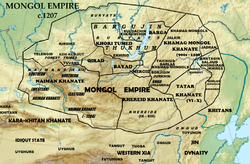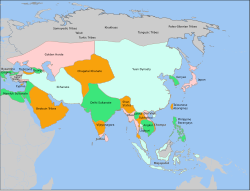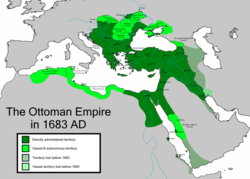World History empires name meanings study guide: Difference between revisions
| Line 319: | Line 319: | ||
!Notes | !Notes | ||
|- | |- | ||
|Notes: | |Notes: | ||
| | | | ||
| | |||
| | |||
| | |||
|- | |||
| colspan="4" | | |||
* "'''Caliphate'''" from "Caliph" which means successor of Muhammad | * "'''Caliphate'''" from "Caliph" which means successor of Muhammad | ||
** literally translated from Arabic = "Successor of the Messenger of God" | ** literally translated from Arabic = "Successor of the Messenger of God" | ||
| Line 335: | Line 340: | ||
** Ali was Muhammad's son-in-law and the husband of his daughter, Fatima | ** Ali was Muhammad's son-in-law and the husband of his daughter, Fatima | ||
** Shiites did not recognize the first three Caliphates as legiitimate | ** Shiites did not recognize the first three Caliphates as legiitimate | ||
| | |<nowiki>[[File:Map of expansion of Caliphate.svg|thumb|Map of expansion of Islamic rule</nowiki> | ||
# Expansion under Muhammad, 622-632 | # Expansion under Muhammad, 622-632 | ||
# Expansion during the Rashidun Caliphate, 632-661 | # Expansion during the Rashidun Caliphate, 632-661 | ||
# Expansion during the Umayyad Caliphate, 661-750 | # Expansion during the Umayyad Caliphate, 661-750 | ||
|- | |- | ||
| | | | ||
| Line 353: | Line 354: | ||
** under the idea, "Muhammad dead, Allah alive" | ** under the idea, "Muhammad dead, Allah alive" | ||
** | ** | ||
| | |632–661 | ||
|Middle East, North Africa, southwestern Anatolia | |Middle East, North Africa, southwestern Anatolia | ||
| | | | ||
* Abu Bakr conquered Arabia and united all the tribes under "umma" | * Abu Bakr conquered Arabia and united all the tribes under "umma" | ||
* did not establish a monarchy, so succession was not hereditary | * did not establish a monarchy, so succession was not hereditary | ||
* all four Rashidun Caliphs were related to Muhammad through marriage | * all four Rashidun Caliphs were related to Muhammad through marriage | ||
| Line 364: | Line 365: | ||
| | | | ||
* 2nd major Caliphate (Sunni) | * 2nd major Caliphate (Sunni) | ||
| | |661–750 | ||
| | | | ||
| | | | ||
| Line 391: | Line 392: | ||
|- | |- | ||
| | | | ||
=== Ottoman | === Ottoman Empire === | ||
| | | | ||
* the 4th caliphate | * "Ottoman Caliphate" is considered the 4th caliphate | ||
|1517–1924 | |1517–1924 | ||
|Middle East, Anatolia, Southeastern Europe, Greece, North Africa | |Middle East, Anatolia, Southeastern Europe, Greece, North Africa | ||
|[[File:OttomanEmpireMain.png|thumb|The Ottoman Empire in 1683|alt=The Ottoman Empire in 1683|none|250x250px]] | |[[File:OttomanEmpireMain.png|thumb|The Ottoman Empire in 1683|alt=The Ottoman Empire in 1683|none|250x250px]] | ||
Revision as of 20:22, 4 January 2023
Goal of this article is to help students identify context and historical recollection via definitions of historical names and terms
- along with memorizing names, places (map literacy) and dates
- historical knowledge and test-day recollection can be enhanced through etymology, or word origins of key historical places, empires or dynasties
Concepts & notes[edit | edit source]
Cultural Diffusion: are conquerors eventually conquered by the conquered?[edit | edit source]
- a common thread to studies of rise and fall of empires and dynasties is cultural diffusion
- cultural diffusion = the spreading and mixing of cultures, populations, technologies, disease, etc.
- we will see in this review over and over how many conquerors become more like the people and places they conquered than what / who they were at the start of the conquest
Standardization & unity[edit | edit source]
- empires rule and spread rule through the process of standardization
- while we think of standardization as making things the same, it can also mean treating disparate groups equally
- i.e., under legal or political standards of either tolerance or favor
- in such systems, different groups may be treated unequally, but in a standardized system, the law or governance treats them consistently, if not equally
- i.e., Islamic legal distinctions between Muslims and non-Muslims
- different taxes, military service, etc.
- i.e., Islamic legal distinctions between Muslims and non-Muslims
- typical methods of standardization and unity include
- writing / language
- laws
- taxation
- currency/ money
- road & canal building
- official religion and/or religious tolerance
China empires/ dynasties[edit | edit source]
| Name | Name definition | Dates | Region | Notes |
|---|---|---|---|---|
| Chinese dynasties follow four general categories of name origins: |
|
| ||
Yuan Dynasty[edit | edit source] |
|
1271–1368 |
| |
Ming Dynasty[edit | edit source] |
|
1368-1644 |
| |
Qing Dynasty[edit | edit source] |
|
1644–1911 | Manchuria, China |
|
Mongol empires[edit | edit source]
| Name | Name definition | Dates | Region | Notes | |
|---|---|---|---|---|---|
Mongol Empire[edit | edit source] |
|
1206–1368 | Eurasia |

 | none |
Yuan Dynasty[edit | edit source] |
see above under China dynasties for Yuan | 1271–1368 | |||
Golden Horde (Mongol)[edit | edit source] |
|
| |||
Chagatai Khanate[edit | edit source] |
|
1242-1347 /
1347-1487 |
| ||
Ilkhanate Khanate[edit | edit source] |
|
1256–1335 | Persia & northern Middle East/ Anatolia |

|
Europe monarchies/ empires[edit | edit source]
India empires[edit | edit source]
| Name | Name definition | Dates | Region | Notes |
|---|---|---|---|---|
| Timurid Empire |
|
1370–1507 | Persia (Iran), central Aisa, northern India |
|
| Mughal Empire |
|
1526–1857 |
Islamic empires[edit | edit source]
| Name | Name definition | Dates | Region | Notes |
|---|---|---|---|---|
| Notes: | ||||
|
[[File:Map of expansion of Caliphate.svg|thumb|Map of expansion of Islamic rule
| |||
Rashidun Caliphate[edit | edit source] |
|
632–661 | Middle East, North Africa, southwestern Anatolia |
|
Umayyad Caliphate[edit | edit source] |
|
661–750 |
| |
Abbasid Caliphate[edit | edit source] |
|
750-1258 | Lower Middle East |
|
| Turks/ Seljuk Turks | ||||
Ottoman Empire[edit | edit source] |
|
1517–1924 | Middle East, Anatolia, Southeastern Europe, Greece, North Africa |  |
Safavid Empire[edit | edit source] |
|
1453-1629 | Persia |
|
